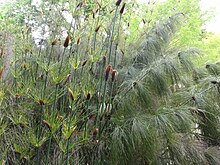Restionaceae
| Restionaceae | |
|---|---|

| |
| Elegia capensis | |
| Scientific classification | |
| Kingdom: | Plantae |
| Clade: | Tracheophytes |
| Clade: | Angiosperms |
| Clade: | Monocots |
| Clade: | Commelinids |
| Order: | Poales |
| Family: | Restionaceae R.Br.
|
The Restionaceae, also called restiads and restios, are a family of flowering plants native to the Southern Hemisphere; they vary from a few centimeters to 3 meters in height. Following the APG IV (2016):[1] the family now includes the former families Anarthriaceae, Centrolepidaceae and Lyginiaceae, and as such includes 51 genera with 572 known species.[2] Based on evidence from fossil pollen, the Restionaceae likely originated more than 65 million years ago during the Late Cretaceous period, when the southern continents were still part of Gondwana.[3][4]
Description
The family consists of tufted or rhizomatous, herbaceous plants belonging to a group of
Distribution
Plants in the family are distributed on all the southern continents -
A number of the largest African species have become popular as garden ornamentals in many parts of the world, some being useful as accent plants similar to small species of bamboo, but with pendant stems of greater delicacy. Also, many smaller species offer a great variety of decorative features and deserve horticultural attention.
Taxonomy
The family Restionaceae has been recognized by most taxonomists. The
Genera
As of 2020[update], Kew's Plants of the World Online lists the following 48 genera in the family Restionaceae:[7]
- Alexgeorgea Carlquist
- Anarthria R.Br.
- Anthochortus Nees ex Endl.
- Aphelia R.Br.
- Apodasmia B.G.Briggs & L.A.S.Johnson
- Askidiosperma Steud.
- Baloskion Raf.
- Calorophus Labill.
- Cannomois P.Beauv. ex Desv.
- Catacolea B.G.Briggs & L.A.S.Johnson
- Centrolepis Labill.
- Ceratocaryum Nees
- Chaetanthus R.Br.
- Chordifex B.G.Briggs & L.A.S.Johnson
- Coleocarya S.T.Blake
- Cytogonidium B.G.Briggs & L.A.S.Johnson
- Dapsilanthus B.G.Briggs & L.A.S.Johnson
- Desmocladus Nees
- Dielsia Gilg
- Elegia L.
- Empodisma L.A.S.Johnson & D.F.Cutler
- Eurychorda B.G.Briggs & L.A.S.Johnson
- Gaimardia Gaudich.
- Hopkinsia W.Fitzg.
- Hydrophilus H.P.Linder
- Hypodiscus Nees
- Hypolaena R.Br.
- Lepidobolus Nees
- Leptocarpus R.Br.
- Lepyrodia R.Br.
- Loxocarya R.Br.
- Lyginia R.Br.
- Mastersiella Gilg-Ben.
- Melanostachya B.G.Briggs & L.A.S.Johnson
- Nevillea Esterh. & H.P.Linder
- Platycaulos H.P.Linder
- Platychorda B.G.Briggs & L.A.S.Johnson
- Restio Rottb.
- Rhodocoma Nees
- Soroveta H.P.Linder & C.R.Hardy
- Sporadanthus F.Muell. ex Buchanan
- Staberoha Kunth
- Taraxis B.G.Briggs & L.A.S.Johnson
- Thamnochortus P.J.Bergius
- Tremulina B.G.Briggs & L.A.S.Johnson
- Tyrbastes B.G.Briggs & L.A.S.Johnson
- Willdenowia Thunb.
- Winifredia L.A.S.Johnson & B.G.Briggs
References
- .
- ^ Bremer, K. (2002). "Gondwanan Evolution of the Grass Alliance of Families (Poales)." Evolution, 56(7): 1374-1387. [1] Archived 2013-07-28 at the Wayback Machine
- ISSN 0075-5974.
- PMID 14761050.
- ^ Restios of the Fynbos - Els Dorrat Haaksma, H. Peter Linder (Botanical Society of South Africa, 2000)
- ^ "Restionaceae R.Br". Plants of the World Online. Royal Botanic Gardens, Kew. Retrieved 1 December 2020.
